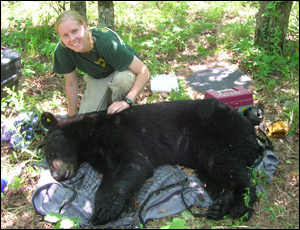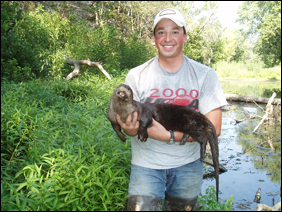OSU students' research may determine fate of hunting seasons
Thursday, September 14, 2006
Oklahoma State University graduate students Dominic Barrett and Angela Brown are surveying the status of Oklahoma’s river otters and black bears in part to determine whether a proposed hunting season may be instituted without detrimentally impacting the species.
After being hunted to near extinction in the early 20th century, otters and black bears are returning to Oklahoma. State legislation passed in May 2006 allowed the Oklahoma Department of Wildlife Conservation to declare hunting/trapping seasons on black bears, river otters and mountain lions. Barrett is studying river otters and Brown is studying black bears.
“The main motivation [for the study] is to determine if there are enough of these two species to provide hunting opportunities to the sportsmen in the state,” said David Leslie, leader of the Oklahoma Cooperative Fish and Wildlife Research Unit at OSU. “These findings will be pivotal to the ODWC’s decision to or not to declare a hunting/trapping season.”
“If they look at the data and believe that the numbers are sufficient, they would very much like to open a season,” said Leslie, who is supervising both students’ research."
Barrett has been studying the state’s river otter population for two years. He used mail-out surveys to gauge the public’s interest in trapping otters.
“We tried to establish how many people would pursue these critters if a season was established,” Barrett said.
The survey results indicated a low level of interest in a new trapping season.


According to Brown, river otters and black bears share a similar story.
“Both were prevalent in the state until the early 1900s when their populations were greatly reduced because of human settlement, habitat destruction and unregulated hunting,” Brown said.
Both Barrett and Brown use harmless catch-and-release methods in their population studies. They assess age, take body measurements and mark their specimens before release. Barrett conducted site surveys to locate otter habitats and examine droppings. Brown set up 128 sampling stations using a type of barbed wire that takes hair samples without causing injury to the bears.
Brown worries that the general public’s irrational fear of bears will lead to overhunting.
“Typically, black bears are quite shy and not prone to attacks,” Brown said. “However, they can become a nuisance. They get into dumps and can break into cabins for food.
“Typically, these cases are handled by tranquilizing and moving the bears into a different place,” she said.
While preliminary results indicate an expansion of otter and bear populations, Brown and Barrett will continue field research and data analysis. Their final reports are planned for release late next year. The decision to create new otter and bear seasons ultimately lies with the Oklahoma Department of Wildlife Conservation.
“I know the ODWC’s decision will be based on the population of bears and not based on pressure from outside sources in favor of bear hunting,” Brown said.
